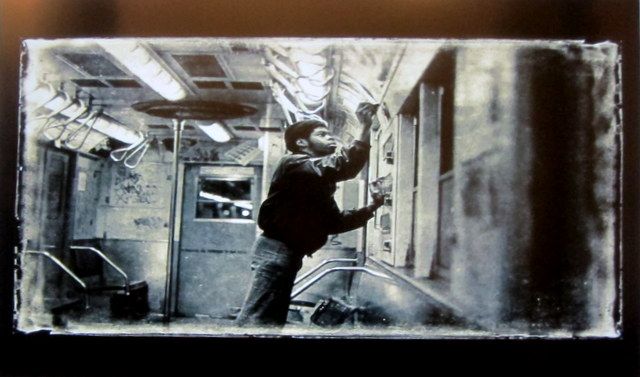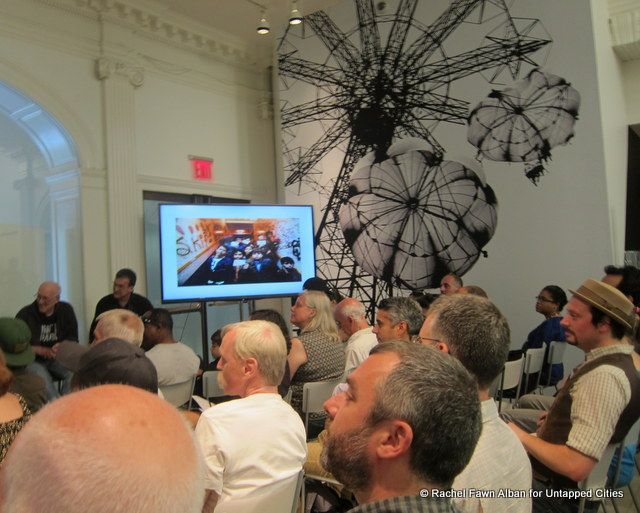A Salvaged Banksy Mural is Now on View in NYC
This unique Banksy mural goes up for auction on May 21st in NYC!


With some exceptions, graffiti often hides in plain sight. But both its creators and the photographers that capture these works of art aren’t always as visible, a pattern the Museum of the City of New York interrupted with its panel discussion last week, On the Front Lines: Graffiti’s Documenters, that brought together photographers featured in the current exhibit City as Canvas: Graffiti Art from the Martin Wong Collection. In a delightful presentation, legendary photographers Martha Cooper, Henry Chalfant, Flint Gennari, and Jon Naar, along with moderator and artist/author Jay J.SON Edlin, shared their images documenting graffiti writing in the 1970s and 1980s. Their stories gave us a glimpse of some of their earliest experiences photographing the graffiti culture.

Graffiti Kids, photograph by Jon Naar, 1973.
Photographer Jon Naar documented New York’s graffiti art movement in 1970s and ’80s including artists, such as the pictured kids, posing with their work.
port. Jon Naar described meeting writers for the first time and realizing they were just young children. He remembered feeling surprised, but not frightened as he shot his iconic photograph, Graffiti Kids (above), and discussed their re
silience in finding ways to survive and thrive in very neglected neighborhoods in the city.
One of the photographs included in the presentation by Henry Chalfant. The photographers would often have kids seeking them out to photograph new work on trains. In this photo, we see Henry’s shadow as he photographs a direct message from a writer.
The photographers further explained how over time, their relationship with the writers became collaborative. Henry Chalfant and Martha Cooper famously had writers calling them about their newest work on trains. As photographers favored certain train lines because of features like lighting, background, and location, eventually writers would gravitate towards those spots too. Young artists would “bomb” specific train lines because they were more likely to be photographed.

A photograph presented by Flint.
For Flint Gennari, the relationship between writer and photographer was even more intimate. He was writer as well as a photographer, documenting his peers and friends. Flint’s work offers a rare glimpse into the graffiti culture of that time, such as this image (above) of a writer tagging inside a subway car.
a train painted by STAY HIGH 149, a pioneer in the writing movement. ” src=”https://untappedcities.com/wp-content/uploads/2014/06/023-Redbird_-Jon-Naar_-1973-MCNY.jpg.jpg” width=”640″ height=”514″ /> Redbird (Stay High 149), photograph by Jon Naar, 1973.
Photographer Jon Naar documented New York’s graffiti art movement in 1970s and ’80s including landscape images of graffiti-covered subway trains rumbling through the city. This particular photograph is of a train painted by STAY HIGH 149, a pioneer in the writing movement.
Since we first interviewed the curator and met some of the artists , we have seen City As Canvas take on a life of it’s own through excellent public programs. What makes these programs special is that they offer the public a rare opportunity to meet and interact with some of the earliest graffiti artists in New York City and their documenting photographers. The book signing and reception after the presentation gave guests plenty of time to mingle.

Pictured: curator Sean Corcoran, Jay Edlin, Martha Cooper, Jon Naar, and Henry Chalfant.
The photographers who documented New York’s graffiti art movement in 1970s and ’80s posing with their work, remind us of their muses, the Graffiti Kids.
The next public program in this series, Graffiti (R)Evolution: Graphic Design and Fine Art, is coming up on Wednesday, July 9 at 6:30 p.m. Join Cey Adams, founding creative director of Def Jam Recordings, and accomplished collage artist Greg Lamarches for a conversation moderated by graffiti artist Dave “Chino” Villorente on the evolution of graffiti from illicit underground movement to international force in the contemporary arts.
And, if you are looking for some kid-friendly Untapped events, be sure to check out the awesome family programs at MCNY.

What makes these programs special is that they offer the public a rare opportunity to meet and interact with some of the earliest graffiti artists in New York City and the documenting photographers.
Take note, the exhibition has been extended and will be on view until Monday, September 1, 2014.
Get in touch with the author at Rachel Fawn Alban and follow her on instagram.
Subscribe to our newsletter